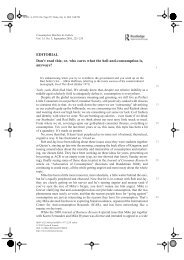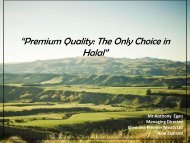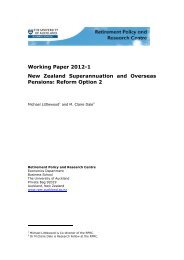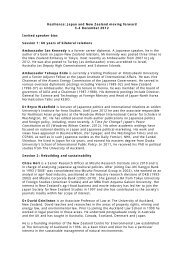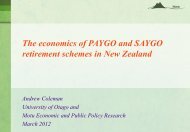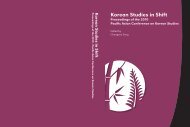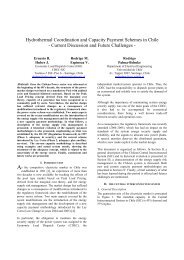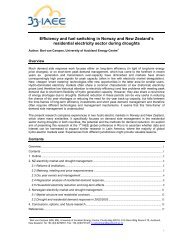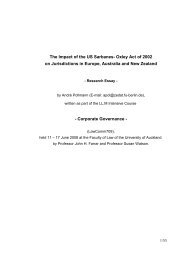1 Maize Supply Response to prices in Nigeria: Application of ARDL a
1 Maize Supply Response to prices in Nigeria: Application of ARDL a
1 Maize Supply Response to prices in Nigeria: Application of ARDL a
You also want an ePaper? Increase the reach of your titles
YUMPU automatically turns print PDFs into web optimized ePapers that Google loves.
<strong>Maize</strong> <strong>Supply</strong> <strong>Response</strong> <strong>to</strong> <strong>prices</strong> <strong>in</strong> <strong>Nigeria</strong>: <strong>Application</strong> <strong>of</strong> <strong>ARDL</strong> and Co-<strong>in</strong>tegration<br />
Analyses <br />
Abstract <br />
OGUNDARI. K and T. NANSEKI 1 <br />
Dept. <strong>of</strong> Agricultural and Resource Economics, Faculty <strong>of</strong> Agriculture, <br />
Kyushu University, Fukuoka, Japan. <br />
The paper seeks <strong>to</strong> estimate the response <strong>of</strong> maize supply <strong>to</strong> <strong>prices</strong> <strong>in</strong> <strong>Nigeria</strong>. Us<strong>in</strong>g both <br />
FMOLS and OLS estima<strong>to</strong>rs, the empirical f<strong>in</strong>d<strong>in</strong>gs show that maize supply responds <br />
significantly and positively <strong>in</strong> the long run <strong>to</strong> own price and negatively (positively) <strong>to</strong> the <br />
price <strong>of</strong> cassava (yam). Other results reveal that maize supply failed <strong>to</strong> respond <br />
significantly <strong>to</strong> changes <strong>in</strong> all the <strong>prices</strong> <strong>in</strong> the short run. While the f<strong>in</strong>d<strong>in</strong>gs show that <br />
short-‐run causality runs only from price <strong>of</strong> cassava <strong>to</strong> maize supply, we also f<strong>in</strong>d that long-run<br />
causality runs from jo<strong>in</strong>t effect <strong>of</strong> the <strong>prices</strong> <strong>to</strong> maize supply. The estimated speed <strong>of</strong> <br />
adjustment has negative sign as expected, but very low at 10% level <strong>of</strong> significance. <br />
Mean<strong>in</strong>g that feedback mechanism is slow <strong>in</strong> converg<strong>in</strong>g maize supply <strong>to</strong>wards long-‐run <br />
equilibrium follow<strong>in</strong>g cumulative shocks/changes <strong>in</strong> maize supply and <strong>prices</strong> <strong>in</strong> the study. <br />
Key words: <strong>ARDL</strong>, Co-‐<strong>in</strong>tegration, <strong>Maize</strong> supply, Price elasticity, <strong>Nigeria</strong> <br />
JEL Classification: C5, O1, Q1 <br />
1.0. Introduction <br />
<strong>Maize</strong> is the most important cereal crop <strong>in</strong> sub-‐Saharan Africa (SSA) and an <br />
important staple food for more than 874.8 million people <strong>in</strong> the region. <strong>Nigeria</strong> is <br />
the largest African producer <strong>of</strong> maize with nearly 8 million <strong>to</strong>ns and an average <br />
yield <strong>of</strong> about 1.5 <strong>to</strong>ns per hectare, which is below the world average <strong>of</strong> 4.3 <br />
<strong>to</strong>ns/ha (FAO, 2012). While the crop is regarded as benchmark for food security <br />
after cassava <strong>in</strong> terms <strong>of</strong> calorie <strong>in</strong>take, the major disturb<strong>in</strong>g news is that there is <br />
shortage <strong>of</strong> food gra<strong>in</strong>s viz. maize with attendant result <strong>of</strong> soar<strong>in</strong>g <strong>prices</strong> <strong>in</strong> the <br />
country (Akanni and Okeowo, 2011). <br />
Broadly speak<strong>in</strong>g, maize production is characterized by a mixed cropp<strong>in</strong>g <br />
pattern <strong>of</strong> production system <strong>in</strong> <strong>Nigeria</strong>. And, traditionally, maize is <strong>of</strong>ten <br />
<strong>in</strong>tercropped with crops such as yam and cassava <strong>in</strong> the country. Mean<strong>in</strong>g that <br />
1 Correspondent author’s email: ogundarikolawole@daad-‐alumni.de <br />
<br />
1
domestic maize supply response <strong>to</strong> own price and <strong>prices</strong> <strong>of</strong> other pr<strong>in</strong>cipal <br />
staples such as yam and cassava is crucial <strong>in</strong> expla<strong>in</strong><strong>in</strong>g the grow<strong>in</strong>g gap between <br />
the demand and supply <strong>of</strong> maize <strong>in</strong> the country ceteris paribus. This observation <br />
is held <strong>in</strong> high esteem by policymakers because responsiveness <strong>of</strong> farmers <strong>to</strong> <br />
economic <strong>in</strong>centives such as price could <strong>in</strong>fluence contribution <strong>of</strong> agriculture <strong>to</strong> <br />
economy (Mushtaq and Dawson, 2002). <br />
S<strong>in</strong>ce agricultural price policy and price mechanism <strong>in</strong> supply response play <br />
important role <strong>in</strong> <strong>in</strong>creas<strong>in</strong>g farm production as noted by Nerlove and Bachman <br />
(1960), the present paper seeks <strong>to</strong> estimate the responsiveness <strong>of</strong> maize supply <br />
<strong>to</strong> own price and <strong>prices</strong> <strong>of</strong> major staples such as yam and cassava <strong>in</strong> <strong>Nigeria</strong>. As <br />
noted by Nkang et al., (2007), measurement <strong>of</strong> supply responsiveness <strong>of</strong> farmers <br />
is a veritable means <strong>of</strong> assess<strong>in</strong>g the impact <strong>of</strong> economic reforms with a view <br />
that policies, which provide appropriate <strong>in</strong>centive such as price or non-‐price <br />
<strong>in</strong>centives are likely <strong>to</strong> br<strong>in</strong>g about high supply responsiveness, while those that <br />
act as dis<strong>in</strong>centives are less likely <strong>to</strong> do so. <br />
Interest<strong>in</strong>gly, if agricultural supply is highly responsive <strong>to</strong> price changes, it is <br />
likely farmers’ behavior <strong>to</strong> produce more can be effectively <strong>in</strong>duced <strong>in</strong>crease <br />
food production and ensur<strong>in</strong>g long-‐term food security. <br />
Given this, the objective <strong>of</strong> the present study as earlier mentioned is <strong>to</strong> estimate <br />
the response <strong>of</strong> maize supply <strong>to</strong> <strong>prices</strong> viz. long run and short run dynamic price <br />
elasticities <strong>of</strong> maize supply <strong>in</strong> <strong>Nigeria</strong>. While the former captures long-‐run price <br />
elasticities, the latter sheds lights on the short run price elasticities, speed <strong>of</strong> <br />
adjustment <strong>to</strong>wards long-‐run equilibrium, and direction <strong>of</strong> causality. Thus, <strong>to</strong> <br />
address the objective empirically, the study uses co-‐<strong>in</strong>tegration analysis, which <br />
<strong>in</strong>corporates more general dynamic structure than the restrictive popular <br />
Nerlovian models <strong>of</strong>ten used <strong>in</strong> agricultural supply response function. Hence, <br />
unlike Nerlovian model, the co<strong>in</strong>tegration approach is useful <strong>in</strong> overcom<strong>in</strong>g the <br />
potential problem <strong>of</strong> spurious regression <strong>in</strong> supply response function. <br />
A search <strong>of</strong> literature shows that a considerable number <strong>of</strong> studies have focused <br />
on agricultural supply response <strong>to</strong> price with wide range <strong>of</strong> crops over the years <br />
<br />
2
<strong>in</strong> <strong>Nigeria</strong>. This <strong>in</strong>cludes Garba et al., (1998), Olubode-‐Awosola et al., (2006); <br />
Nkang et al., (2007), Ogazi, 2009; Aje<strong>to</strong>mobi (2010), and Akanni and Okeowo <br />
(2011) <strong>to</strong> mention a few. Interest<strong>in</strong>gly, many <strong>of</strong> these studies used co-‐<strong>in</strong>tegration <br />
analysis and it implied error correction model <strong>in</strong>stead <strong>of</strong> the traditional <br />
Nerlovian model. But the present study aims <strong>to</strong> further contribute <strong>to</strong> the supply <br />
response literature <strong>in</strong> the country <strong>in</strong> two ways. First, <strong>in</strong> contrast <strong>to</strong> the popular <br />
Johansen and Engle-‐ Granger techniques used by the aforementioned studies, the <br />
present study uses au<strong>to</strong> regressive distributive lag (<strong>ARDL</strong>) <strong>to</strong> <strong>in</strong>vestigate the <br />
existence <strong>of</strong> co-‐<strong>in</strong>tegration relationship. S<strong>in</strong>ce, small sample size <strong>of</strong>ten <br />
characterize study <strong>of</strong> this nature, the use <strong>of</strong> the Johansen and Engle-‐ Granger <br />
techniques for sample size that is less than 80 observations is likely <strong>to</strong> produce <br />
bias results (see, Pesaran et al., 2001; Narayan, 2005 for detail). Second, the <br />
present study uses new generation co-‐<strong>in</strong>tegration panel and time series <br />
regression estima<strong>to</strong>r such as modified ord<strong>in</strong>ary least square (FMOLS) <strong>in</strong> <br />
comparison with the traditional response function (OLS) <strong>to</strong> analyze the long run <br />
and short run maize supply response <strong>to</strong> <strong>prices</strong> <strong>in</strong> the study. Although, asymp<strong>to</strong>tic <br />
distribution <strong>of</strong> FMOLS and OLS estima<strong>to</strong>rs are normally distributed, the results <br />
<strong>of</strong> the two estima<strong>to</strong>rs appear mixed. For example, Kao (1999) argued that the <br />
bias –corrected OLS estima<strong>to</strong>r such as FMOLS does not improve over the OLS, <br />
nevertheless, the author concluded that FMOLS might be more promis<strong>in</strong>g <strong>in</strong> co-<strong>in</strong>tegration<br />
analysis. While study the f<strong>in</strong>ite properties <strong>of</strong> the OLS and FMOLS <br />
estima<strong>to</strong>rs <strong>in</strong> co-‐<strong>in</strong>tegration analysis, Kao and Chiang (2000) found that FMOLS <br />
estima<strong>to</strong>r does not improve over OLS. But recent study by Wang et al., (2009) <br />
found that FMOLS outperform OLS slightly <strong>in</strong> co-‐<strong>in</strong>tegration analysis. In view <strong>of</strong> <br />
this development, both the OLS and FMOLS estima<strong>to</strong>rs are employed <strong>in</strong> the <br />
present study <strong>to</strong> further shed light on this <strong>in</strong>conclusive result <strong>in</strong> the literature. <br />
The rest <strong>of</strong> the paper is organized as follows. Section two focuses on the <br />
conceptual framework and empirical model, while section three provides <br />
detailed descriptive statistics <strong>of</strong> the data used. Section four presents the results <br />
and discussion. Conclusion and policy implication are provided <strong>in</strong> section five. <br />
<br />
3
2.0. Conceptual framework and empirical models <br />
2.1. Conceptual framework <br />
The estimation <strong>of</strong> agricultural supply response is based on two identified <br />
frameworks viz. Nerlovian expectation model and pr<strong>of</strong>it-‐maximiz<strong>in</strong>g approach. <br />
While, the former captures the dynamics <strong>of</strong> agriculture by <strong>in</strong>corporat<strong>in</strong>g price <br />
expectations and /or adjustment costs; the later <strong>in</strong>volves jo<strong>in</strong>t estimation <strong>of</strong> <br />
output supply and <strong>in</strong>put demand functions (Mythili, 2008). In contrast, <strong>to</strong> the <br />
Nerlovian model, the pr<strong>of</strong>it maximiz<strong>in</strong>g approach requires detailed <strong>in</strong>formation <br />
on the quantities and the <strong>in</strong>put <strong>prices</strong>, which is not available for the present <br />
study. Based on this, the present study employed Nerlovian expectation model as <br />
a framework for the maize supply response <strong>in</strong> <strong>Nigeria</strong>. <br />
As earlier mentioned, the Nerlovian expectation model is a dynamic model, <br />
which captures the delay <strong>in</strong> agricultural production due <strong>to</strong> resource availability <br />
with<strong>in</strong> one or two agricultural production cycles (Nerlove, 1958). Thus, <br />
follow<strong>in</strong>g Nerlovian framework for supply response where desired output (Y t * ) <br />
is expressed as a function <strong>of</strong> price expectation P t e <strong>in</strong> period “t” and def<strong>in</strong>ed as <br />
Y t * = α + βP t e + ε t 1<br />
where, Y t * is desired output or a given output, P t e is the expected relative <strong>prices</strong> at <br />
period “t” ; β is the long-‐run price elasticity <strong>of</strong> supply, and ε t is unobserved <br />
random term for the regression. <br />
Furthermore, follow<strong>in</strong>g the work <strong>of</strong> Nerlove (1958), the dynamics agricultural <br />
supply is expressed as a weight sum <strong>of</strong> past output, <strong>in</strong> which the weights decl<strong>in</strong>e <br />
as one goes back <strong>in</strong> time and def<strong>in</strong>ed as <br />
Y t<br />
= Y t−1<br />
+ δ Y t * − Y t−1<br />
( ) +ν t 2 <br />
where, Y t is the actual output supply; Y t<br />
*<br />
is as def<strong>in</strong>ed earlier; δ is the partial; <br />
adjustment coefficient and ν t is the error/random term for the regression. <br />
Accord<strong>in</strong>gly, the adjustment coefficient “δ ” represents the actual change <strong>in</strong> <br />
output between two periods, which also represents a fraction <strong>of</strong> the change <br />
required <strong>to</strong> achieve the optimal output level Y t<br />
*<br />
. If "δ " is close <strong>to</strong> zero, then it <br />
implies that farmers adjustment <strong>of</strong> actual output <strong>to</strong> desired output is slow. <br />
<br />
4
Likewise, if "δ " is close <strong>to</strong> 1,it is an <strong>in</strong>dication that farmers’ adjustment <strong>of</strong> actual <br />
output <strong>to</strong> desired output is fast. However, <strong>in</strong> equation 2, we assumed that only <br />
<strong>in</strong>formation on past <strong>prices</strong> is taken <strong>in</strong><strong>to</strong> account by the economic agents <strong>in</strong>volved <br />
<strong>in</strong> the output supply Y t . <br />
Hence, the structural Nerlovian model represented by equations 1 and 2 when <br />
comb<strong>in</strong>e yields the reduce form def<strong>in</strong>ed as 2 <br />
Y t<br />
= δα + ( 1− δ )Y t−1<br />
+ δβP e t<br />
+ τ t<br />
3 <br />
where, τ t<br />
= ε t<br />
+ν t<br />
; δβ and β are the short-‐run and long-‐run price elasticities <strong>of</strong> <br />
supply, respectively; Y t<br />
is the output supply, Y t−1<br />
is the lagged value <strong>of</strong> Y t<br />
, P t e is <br />
the price expectation; δ , α , and β are the parameters <strong>to</strong> be estimated, and τ t<br />
is <br />
the error term for the regression. <br />
S<strong>in</strong>ce, price expectation are updated from one period <strong>to</strong> another <strong>in</strong> proportion, <br />
the difference between observed price and expected price levels <strong>of</strong> the previous <br />
period can be def<strong>in</strong>ed as ( see Nerlove, 1958 for details) <br />
P e e<br />
t<br />
− P t−1<br />
( ) ⇒ P t e = βP t−1<br />
− 1− β<br />
e<br />
= β P t−1<br />
− P t−1<br />
e<br />
( )P t−1<br />
Accord<strong>in</strong>g <strong>to</strong> Kanwar, (2006), if quasi-‐rational expectation hypothesis is <br />
considered, then equation 4a can be expressed as <strong>in</strong>f<strong>in</strong>ite-‐order <strong>of</strong> <br />
au<strong>to</strong>regressive process such as <br />
∞<br />
P e t<br />
= ∑ β ( 1− β ) ι−1 P t−ι<br />
4b <br />
ι=1<br />
where β is the adapted price coefficient also know as price elasticity <strong>of</strong> supply, <br />
which ranges 0 < β < 1. <br />
However, substitut<strong>in</strong>g equation 4b <strong>in</strong><strong>to</strong> 3 gives the reduced form <br />
Y t<br />
= δα + ( 1− δ )Y t−1<br />
+ δβP t−1<br />
+ τ t<br />
5 <br />
Equation 5 shows that output supply Y t<br />
can be expressed as a function <strong>of</strong> its <br />
lagged value <strong>in</strong>cluded <strong>to</strong> ma<strong>in</strong>ta<strong>in</strong> the dynamics nature <strong>of</strong> agricultural production <br />
as earlier discussed and lagged <strong>prices</strong>, which <strong>in</strong>clude own and cross <strong>prices</strong>. <br />
Theoretically, <strong>in</strong> case <strong>of</strong> agricultural supply function, we expect output supply Y t<br />
<br />
4a <br />
2 For the manipulation, see Lim, 1975 for the details<br />
<br />
5
<strong>to</strong> respond <strong>to</strong> own price with higher output and complementary (or compet<strong>in</strong>g) <br />
crops with positive (or negative) cross-‐price elasticities. But equation 3 can also <br />
be extended <strong>to</strong> <strong>in</strong>clude control variables other than price such as time trend, <br />
variables represent<strong>in</strong>g weather such as ra<strong>in</strong>fall etc., policy <strong>in</strong>dica<strong>to</strong>r etc. <strong>to</strong> <br />
capture imperfect <strong>in</strong>formation <strong>in</strong> the variables. <br />
A fundamental methodological weakness <strong>of</strong> the Nerlove model comes down <strong>to</strong> <br />
the crude decision rule that <strong>in</strong> each period, a fraction <strong>of</strong> the difference between <br />
Y t<br />
and Y * t<br />
is elim<strong>in</strong>ated as shown <strong>in</strong> equation2. Accord<strong>in</strong>g <strong>to</strong> Thiele (2000), the <br />
Nerlove method assumed a fixed target supply based on stationary expectation. <br />
Based on this, the author argue that estimat<strong>in</strong>g Nerlove method is unlikely <strong>to</strong> <br />
capture the full dynamics <strong>of</strong> supply, thus bias<strong>in</strong>g elasticity downwards. An <br />
alternative approach <strong>to</strong> Nerlove method is the use <strong>of</strong> co-‐<strong>in</strong>tegration analysis and <br />
dynamic general equilibrium models as noted by Abdulai and Rieder, (1995) and <br />
Thiele, (2000). The former will be used <strong>in</strong> this paper. <br />
2.2. Empirical Model <br />
2.2.1. <strong>ARDL</strong> <strong>to</strong> Co-‐<strong>in</strong>tegration test <br />
The use <strong>of</strong> co-‐<strong>in</strong>tegration analysis for output supply response requires that the <br />
variables <strong>in</strong> supply function must have co-‐<strong>in</strong>tegration relationship (Thiele, <br />
2000). However, <strong>in</strong> recognition <strong>of</strong> the concern raised <strong>in</strong> the literature on <br />
appropriate technique <strong>to</strong> <strong>in</strong>vestigate the existence <strong>of</strong> co-‐<strong>in</strong>tegration relationship <br />
between pair <strong>of</strong> series with small sample size and also when variables are not <br />
<strong>in</strong>tegrated <strong>of</strong> the same order, we employed the <strong>ARDL</strong> approach that is based on <br />
bound test (see, Narayan, 2005). <br />
Broadly speak<strong>in</strong>g, <strong>ARDL</strong> <strong>of</strong>fers explicit test for the existence <strong>of</strong> a unique co-<strong>in</strong>tegration<br />
vec<strong>to</strong>r rather than assum<strong>in</strong>g one, while it also takes <strong>in</strong><strong>to</strong> account the <br />
possibility <strong>of</strong> reverse causality (i.e., the absence <strong>of</strong> weak exogeneity <strong>of</strong> the <br />
regressors) thereby ensur<strong>in</strong>g that the parameter estimates are efficient and <br />
consequently valid (Pesaran et al., 2001). Besides, <strong>ARDL</strong> <strong>of</strong>fers a more significant <br />
approach for determ<strong>in</strong><strong>in</strong>g co-‐<strong>in</strong>tegration relationship <strong>in</strong> small sample, especially <br />
when sample size is less than 80 observations, while the Johansen approach and <br />
Engle-‐Granger procedure require large data sample for the purpose <strong>of</strong> validity. <br />
<br />
6
Also, contrary <strong>to</strong> Johansen approach, <strong>ARDL</strong> avoids concerns associated with the <br />
large number <strong>of</strong> choices that must be made. Among these choices are decision <br />
regard<strong>in</strong>g the number <strong>of</strong> endogenous and exogenous variables (if any) <strong>to</strong> be <br />
<strong>in</strong>cluded, treatment <strong>of</strong> determ<strong>in</strong>istic element as well as the order <strong>of</strong> the vec<strong>to</strong>r <br />
au<strong>to</strong>regressive (VAR) and the optimal number <strong>of</strong> lags <strong>to</strong> be specified. F<strong>in</strong>ally, <br />
while Johansen approach and other techniques require that all series <strong>to</strong> be <br />
<strong>in</strong>tegrated <strong>of</strong> the same order, the <strong>ARDL</strong> overcome this by provid<strong>in</strong>g a feasible <br />
application on mixed series (see, Pesaran et al., 2001 for details). 3 <br />
To this end, the <strong>ARDL</strong> used for the study is def<strong>in</strong>ed below <br />
k<br />
ΔlnY maize t<br />
= α 0<br />
+ ω j<br />
ΔlnY maize<br />
maize<br />
∑ t− j<br />
+ ∑ γ j<br />
ΔlnP t− j<br />
+ ∑δ j<br />
ΔlnP t- j<br />
k<br />
∑<br />
j=1<br />
+ ϑ j<br />
ΔlnP t- j<br />
j=1<br />
cassava<br />
k<br />
j=1<br />
k<br />
j=1<br />
+φ 1<br />
lnP maize t−1<br />
+φ 2<br />
lnP yam t−1<br />
+φ 3<br />
lnP cassava t−1<br />
+η t<br />
6<br />
where Δ is change opera<strong>to</strong>r, ln is the natural logarithm, k = 2 and this is the <br />
yam<br />
number <strong>of</strong> lags used 4 , Y t maize is maize output supply <strong>in</strong> <strong>to</strong>ns; P t maize , P t yam<br />
and <br />
P t cassava are the <strong>prices</strong> per <strong>to</strong>n <strong>of</strong> maize, yam and cassava, respectively; ω j<br />
,γ j<br />
,δ j<br />
,<br />
ϑ j<br />
,φ 1<br />
,φ 2<br />
, and φ 3<br />
are the parameters <strong>to</strong> be estimated, and η t<br />
is the error term <strong>of</strong> <br />
the regression. <br />
From equation 6, the null hypothesis <strong>of</strong> no co-‐<strong>in</strong>tegration is def<strong>in</strong>ed as <br />
H0 = φ1 = φ2 = φ3 = 0. Hence, the test statistics for the null hypothesis <strong>of</strong> no co-‐<br />
<strong>in</strong>tegration between the maize supply and <strong>prices</strong> <strong>of</strong> maize, yam and cassava <br />
series <strong>in</strong> equation 6 is based on a F-‐statistics or Wald test statistics, while critical <br />
value is from bound test developed by Pesaran et al., (2001) for large sample size <br />
and later extended by Narayan (2005) <strong>to</strong> cover studies with small sample size. <br />
3 The prelim<strong>in</strong>ary analysis <strong>of</strong> time series property <strong>of</strong> the variables, <strong>in</strong> particular unit root test, which will be <br />
discussed later <strong>in</strong> the paper shows the variables are not <strong>of</strong> the same order. <br />
4 The number <strong>of</strong> lags is guided by the Akaike Information Criterion (AIC) <br />
<br />
7
2.2.2. Co-‐<strong>in</strong>tegration Analysis <br />
As mentioned earlier, the study <strong>in</strong>tends <strong>to</strong> use co-‐<strong>in</strong>tegration analysis, which <br />
does not impose restriction on the short-‐run behavior <strong>of</strong> <strong>prices</strong> and quantities <strong>to</strong> <br />
estimate maize supply response <strong>to</strong> <strong>prices</strong>. S<strong>in</strong>ce, co-‐<strong>in</strong>tegration analysis only <br />
requires co-‐movement <strong>of</strong> output supply and the <strong>prices</strong> <strong>in</strong> the long run, a typical <br />
long-‐run equilibrium and short run dynamic supply response functions with<strong>in</strong> <br />
the framework <strong>of</strong> co-‐<strong>in</strong>tegration analysis for this study are discussed below. <br />
Long-‐run equilibrium supply function <br />
The long-‐run equilibrium supply response function for the study can be <br />
expressed as follows <br />
lnY t maize =ι 0<br />
+ϕ 1<br />
lnP t maize +ϕ 2<br />
lnP t yam +ϕ 3<br />
lnP t cassava +u t<br />
<br />
7 <br />
where, ln is the natural logarithm, Y t maize is maize output supply <strong>in</strong> <strong>to</strong>ns; P t maize , <br />
P t yam and P t cassava are the <strong>prices</strong> per <strong>to</strong>n <strong>of</strong> maize, yam, and cassava, respectively <br />
considered as a major determ<strong>in</strong>ants <strong>of</strong> maize supply Y t maize <strong>in</strong> the study. 5 <br />
Short-‐run dynamics supply function <br />
A typical short run dynamic function for estimat<strong>in</strong>g short-‐run elasticity can be <br />
def<strong>in</strong>ed us<strong>in</strong>g the relationship below <br />
k<br />
ΔlnY maize t<br />
= σ 0<br />
+ ∑ ϑ j<br />
ΔlnY maize<br />
t− j<br />
+ ∑β j<br />
ΔlnP t− j<br />
k<br />
j=1<br />
k<br />
j=1<br />
maize<br />
yam<br />
cassava<br />
+ ∑ θ j<br />
ΔlnP t- j<br />
+ ∑ χ j<br />
ΔlnP t- j<br />
+ςECT t−1<br />
+ ϖ t<br />
8<br />
j=1<br />
k<br />
j=1<br />
5 While we recognized that other non-‐fac<strong>to</strong>rs such as biophysical condition viz. ra<strong>in</strong>fall, <strong>in</strong>frastructure and <br />
capita <strong>in</strong>vestment can affect agricultural supply; they are not <strong>in</strong>cluded <strong>in</strong> the analysis because <strong>in</strong>formation <br />
on these variables is not readily available. However, we are confidence that s<strong>in</strong>ce price is a direct policy <br />
<strong>in</strong>strument, the result <strong>of</strong> this analysis is expected <strong>to</strong> help policymakers <strong>in</strong> policy design <strong>in</strong> the country. <br />
<br />
8
where, ECT ˆ<br />
t−1 = u is the error correction term, which is equivalent <strong>to</strong> the <br />
t−1<br />
lagged value <strong>of</strong> the error term from the equation 7;k=3 and this is the number <strong>of</strong> <br />
lagged used; 6 β j<br />
, θ j<br />
, and χ j<br />
represents short-‐run price elasticities <strong>of</strong> supply; ς <br />
is the coefficient <strong>of</strong> the error correction term, which denotes the speed <strong>of</strong> <br />
adjustment <strong>to</strong>wards long run equilibrium. The later measures the period <strong>of</strong> <br />
feedback or convergence <strong>of</strong> maize supply <strong>in</strong><strong>to</strong> a long-‐run equilibrium follow<strong>in</strong>g <br />
changes <strong>in</strong> maize supply and the <strong>prices</strong>, and ϖ t<br />
is the error term <strong>of</strong> the <br />
regression. <br />
The Causality Tests <br />
Although, the existence <strong>of</strong> a long run equilibrium relationship is an <strong>in</strong>dication <strong>of</strong> <br />
causality <strong>in</strong> at least one direction, it is fundamentally important <strong>to</strong> test the <br />
direction <strong>of</strong> causality between economic data, especially where there is a strong <br />
<strong>in</strong>dication <strong>of</strong> endogeneity <strong>in</strong> the series. Thus, from equation 8, the jo<strong>in</strong>t <br />
significance <strong>of</strong> the coefficient <strong>of</strong> lagged <strong>prices</strong> ΔlnP maize t− j<br />
, ΔlnP yam cassava<br />
t- j<br />
, and ΔlnP t- j<br />
provide evidence <strong>of</strong> short-‐run causality from the <strong>prices</strong> <strong>to</strong> the output supply. <br />
Likewise, the F-‐statistics <strong>of</strong> the coefficient <strong>of</strong> error correction term provides <br />
evidence <strong>of</strong> long-‐run causality from the jo<strong>in</strong>t effect <strong>of</strong> the <strong>prices</strong> <strong>to</strong> the output <br />
supply. These tests are very important <strong>to</strong> provide <strong>in</strong>sights <strong>to</strong> which <strong>of</strong> the <br />
variables Granger cause maize supply (Y t maize ). <br />
Short-‐run causality <br />
The underly<strong>in</strong>g null hypothesis for test<strong>in</strong>g whether short-‐run causality exists is <br />
based on jo<strong>in</strong>t significance <strong>of</strong> the lagged coefficient <strong>of</strong> the <strong>prices</strong> as <br />
H 0 1 :<br />
H 0 1 :<br />
H 0 1 :<br />
k<br />
∑<br />
j=1<br />
β j<br />
k<br />
θ j<br />
j=1<br />
∑<br />
k<br />
∑<br />
j=1<br />
χ j<br />
= 0 i.e.,short runs from P maize maize<br />
( t<br />
→ Y t )<br />
= 0 i.e.,short runs from P yam maize<br />
( t<br />
→ Y t )<br />
= 0 i.e.,short runs from P cassava maize<br />
( t<br />
→ Y t )<br />
9 <br />
6 We use a maximum three lags <strong>to</strong> capture most dynamic adjustment observable <strong>in</strong> the series. In l<strong>in</strong>e with <br />
AIC. <br />
<br />
9
Long-‐run causality test <br />
The underly<strong>in</strong>g hypothesis for test<strong>in</strong>g long run causality is based on the <br />
significance <strong>of</strong> the coefficient <strong>of</strong> the speed <strong>of</strong> adjustment <strong>of</strong> equation 8 as <br />
H 0 2 :ς = 0 <br />
10 <br />
Strong causality test <br />
The strong causality test is carried further <strong>to</strong> exam<strong>in</strong>e the jo<strong>in</strong>t significance <strong>of</strong> the <br />
short and long run causality on maize supply as <br />
k<br />
H 3 0<br />
: ∑ β j<br />
+ ∑ θ j<br />
+ ∑ χ j<br />
+ ς = 0 11 <br />
j=1<br />
k<br />
j=1<br />
k<br />
j=1<br />
Intuitively, we expect a unidirectional causality from the <strong>prices</strong> <strong>of</strong> the staples <strong>to</strong> <br />
maize supply, while reverse causality from maize supply <strong>to</strong> staple <strong>prices</strong> does <br />
not hold <strong>in</strong> pr<strong>in</strong>ciple. The parameters <strong>of</strong> equation 6-‐11 and unit root tests were <br />
carried out us<strong>in</strong>g EVIEWS 7.2. <br />
3.0. The Data and sources <strong>of</strong> the data <br />
The study used annual time series data obta<strong>in</strong>ed from various edition <strong>of</strong> annual <br />
abstract <strong>of</strong> statistics <strong>of</strong> Central Bank <strong>of</strong> <strong>Nigeria</strong> (CBN)’s Economic and F<strong>in</strong>ancial <br />
Review and Statistical Bullet<strong>in</strong> (CBN several issues). Additional <strong>in</strong>formation was <br />
also sourced from FAOSTAT data (FAO, 2012). In all, the data used covered <br />
1961-‐2008 (i.e., 48 observations). Information obta<strong>in</strong>ed from these database <br />
<strong>in</strong>cludes maize supply <strong>in</strong> <strong>to</strong>ns and own real price per <strong>to</strong>n <strong>in</strong> <strong>Nigeria</strong> currency unit <br />
(Naira). Besides, <strong>in</strong>formation on real price per <strong>to</strong>n <strong>of</strong> yam and cassava was also <br />
sourced from the CBN and FAO database for the analysis. Detailed descriptive <br />
statistics <strong>of</strong> the series used <strong>in</strong> the analysis are presented <strong>in</strong> table A <strong>of</strong> the <br />
appendix. <br />
4.0 Results and Discussion <br />
4.1. Time series property <strong>of</strong> the data (unit root test) <br />
Generally, the advantage <strong>of</strong> us<strong>in</strong>g co-‐<strong>in</strong>tegration over Nerlovian model <strong>in</strong> supply <br />
response model<strong>in</strong>g is due <strong>to</strong> the fact that the technique <strong>of</strong>fers a means <strong>of</strong> <br />
<br />
10
identify<strong>in</strong>g non-‐stationary series and hence avoid<strong>in</strong>g spurious regression via co-<strong>in</strong>tegration<br />
analysis (Abdulai and Rieder, 1995). In other words, the variables <strong>in</strong> <br />
supply response must be co-‐<strong>in</strong>tegrated. <br />
Unfortunately, many economic data are non-‐stationary and based on this, <br />
ord<strong>in</strong>ary least squares (OLS) regression between non-‐stationary data is likely <strong>to</strong> <br />
give spurious results (Harris, 1995). To this end, we take a closer look at the <br />
time series property <strong>of</strong> the data viz. unit root <strong>of</strong> the series (maize supply, maize <br />
price, yam price and cassava price). <br />
Table 1a and 1b present the result <strong>of</strong> the unit root test based on ADF and KPSS, <br />
respectively. The ADF test is under the null hypothesis <strong>of</strong> a unit root (I (1)), while <br />
the alternative hypothesis is stationarity <strong>in</strong> the series (I (0)). The KPSS test is <br />
under the null hypothesis <strong>of</strong> stationarity (I (0)), while the alternative hypothesis <br />
is unit root <strong>in</strong> the series (I (1)). The number <strong>of</strong> the lags is guided by the Akaike <br />
Information Criterion (AIC) <strong>to</strong> ensure that the serial correlation <strong>in</strong> the series is <br />
absent. Hence, the results presented <strong>in</strong> the tables show that almost all the series <br />
are <strong>in</strong> the same order at the level and first difference, especially when the <br />
determ<strong>in</strong>istic is def<strong>in</strong>ed as constant. <br />
Table 1A: ADF unit root test <br />
Variables Determ<strong>in</strong>ants Level Difference <br />
t-‐statistics CV (5%) Decision t-‐statistics CV (5%) Decision <br />
<strong>Maize</strong> output Constant -‐3.6383 -‐2.9252 I (0) -‐7.0866 -‐2.9266 I (0) <br />
Constant + Trend -‐1.8978 -‐3.5085 I (1) -‐7.0317 -‐3.5107 I (0) <br />
<strong>Maize</strong> price Constant -‐2.9742 -‐2.9252 I (0) -‐7.1162 -‐2.9266 I (0) <br />
Constant + Trend -‐3.1928 -‐3.5085 I (1) -‐7.0557 -‐3.5107 I (0) <br />
Yam price Constant -‐2.9848 -‐2.9252 I (0) -‐9.0843 -‐2.9266 I (0) <br />
Constant + Trend -‐4.1966 -‐3.5085 I (0) -‐8.9825 -‐3.5107 I (0) <br />
Cassava Price Constant -‐3.6099 -‐2.9252 I (0) -‐7.8667 -‐2.9266 I (0) <br />
Constant + Trend -‐3.5358 -‐3.5085 I (0) -‐7.8229 -‐3.5107 I (0) <br />
Note: The variables are with maximum <strong>of</strong> one lag; CV denoted critical value <br />
Table 1B: KPSS <br />
Variables Determ<strong>in</strong>ants Level Difference <br />
LM-‐statistics CV (5%) Decision LM-‐statistics CV (5%) Decision <br />
<strong>Maize</strong> output Constant 0.7055 0.4630 I (1) 0.1237 0.4630 I (0) <br />
Constant + Trend 0.1081 0.1460 I (0) 0.0955 0.1460 I (0) <br />
<strong>Maize</strong> price Constant 0.2597 0.4630 I (0) 0.f4058 0.4630 I (0) <br />
Constant + Trend 0.1577 0.1460 I (1) 0.3559 0.1460 I (1) <br />
Yam price Constant 0.7661 0.4630 I (1) 0.1306 0.4630 I (0) <br />
Constant + Trend 0.0866 0.1460 I (0) 0.1291 0.1460 I (0) <br />
Cassava Price Constant 0.1613 0.4630 I (0) 0.2106 0.4630 I (0) <br />
Constant + Trend 0.1340 0.1460 I (0) 0.1281 0.1460 I (0) <br />
Note: The variables are with maximum <strong>of</strong> one lag; CV denoted critical value. <br />
<br />
11
4.2. The <strong>ARDL</strong> test <strong>of</strong> co-‐<strong>in</strong>tegration relationship <br />
Follow<strong>in</strong>g the result <strong>of</strong> the unit root tests, we sought <strong>to</strong> determ<strong>in</strong>e the existence <br />
<strong>of</strong> co-‐<strong>in</strong>tegration relationship between the series. Given this, Table 2 presents the <br />
results <strong>of</strong> the <strong>ARDL</strong> bound test based on equation 6 for both the FMOLS and OLS <br />
estima<strong>to</strong>rs with maximum lag <strong>of</strong> two, no trend and unrestricted <strong>in</strong>tercept with <br />
an estimated F-‐statistics <strong>of</strong> 5.247 and 5.953 for the OLS and FMOLS estima<strong>to</strong>rs, <br />
respectively. Both statistics are higher than the upper bound critical value <strong>of</strong> <br />
5.207 at 5% level <strong>of</strong> significance obta<strong>in</strong>ed from Narayan’s (2005) table. The <br />
implication <strong>of</strong> this is that the null hypothesis <strong>of</strong> no co-‐<strong>in</strong>tegration between the <br />
maize supply, maize price, yam price and cassava price cannot be accepted <strong>in</strong> the <br />
study. <br />
Table 2: Bound test for co-‐<strong>in</strong>tegration <br />
Null Hypothesis F statistics Critical value bounds: unrestricted <strong>in</strong>tercept and no trend with <br />
k=2 and N=45 <br />
10% level 5% level 1% level <br />
I (0) I (1) I (0) I (1) I (0) I (1) <br />
H0 = φ1 = φ2 = φ3 = 0 5.247 (OLS) <br />
5.953 (FMOLS) 3.330 4.347 4.083 5.207 5.920 7.197 <br />
Note: Critical values from Narayan (2005); I (0) and I (1) represent the lower and upper bound critical values, respectively. <br />
4.3. Long-‐run equilibrium elasticities <br />
Follow<strong>in</strong>g the evidence <strong>of</strong> co-‐<strong>in</strong>tegration relationship between the co-‐<strong>in</strong>tegrat<strong>in</strong>g <br />
vec<strong>to</strong>rs, we present <strong>in</strong> Table 3 the results <strong>of</strong> long-‐run price elasticities <strong>of</strong> maize <br />
supply for both the OLS and FMOLS estima<strong>to</strong>rs. And the results show that maize <br />
supply responds significantly <strong>to</strong> own price and <strong>prices</strong> <strong>of</strong> other staples considered <br />
<strong>in</strong> the analysis. In particular, the estimated elasticities from both the OLS and <br />
FMOLS estima<strong>to</strong>rs show that 1% <strong>in</strong>crease <strong>in</strong> price <strong>of</strong> maize <strong>in</strong>creased maize <br />
supply by 0.88% and 0.95%, respectively, which is consistent with standard <br />
production theory: a positive supply response <strong>to</strong> own price. Mean<strong>in</strong>g that both <br />
estima<strong>to</strong>rs show that the long-‐run price elasticity <strong>of</strong> maize supply <strong>to</strong> own price is <br />
<strong>in</strong>elastic (i.e., less than one). This result perhaps further lends support <strong>to</strong> the <br />
argument <strong>in</strong> the literature that farmers <strong>in</strong> the less developed countries respond <br />
slowly <strong>to</strong> economic <strong>in</strong>centives such as price (Mythili, 2008). Thus, the author <br />
outl<strong>in</strong>ed 4 major likely reasons for this observation <strong>in</strong> the develop<strong>in</strong>g economies, <br />
<br />
12
which <strong>in</strong>cludes constra<strong>in</strong>ts on irrigation, limited access <strong>to</strong> <strong>in</strong>puts, high <br />
transaction cost, or <strong>in</strong>frastructure <strong>to</strong> lack <strong>of</strong> complementary agricultural policies. <br />
The implication <strong>of</strong> this reason<strong>in</strong>g <strong>to</strong> the f<strong>in</strong>d<strong>in</strong>gs <strong>of</strong> this paper is that pric<strong>in</strong>g <br />
policy alone may not be sufficient <strong>in</strong>strument <strong>to</strong> enhance maize production <strong>in</strong> <br />
<strong>Nigeria</strong>n. <br />
Also, the results <strong>of</strong> the price elasticity <strong>of</strong> maize supply <strong>to</strong> the <strong>prices</strong> <strong>of</strong> other <br />
important staples considered <strong>in</strong> the analysis shows that 1% <strong>in</strong>crease <strong>in</strong> the price <br />
<strong>of</strong> yam <strong>in</strong>creased maize supply by 1.52% and 2.2% for OLS and FMOLS <br />
estima<strong>to</strong>rs, respectively. Other results also show that 1% <strong>in</strong>crease <strong>in</strong> cassava <br />
price decreased maize supply by 0.76% and 0.95% for OLS and FMOLS <br />
estima<strong>to</strong>rs, respectively. Intuitively, a negative (or positive) maize supply <br />
response <strong>to</strong> <strong>in</strong>crease <strong>in</strong> <strong>prices</strong> other than own price implied a response <strong>to</strong> <br />
compet<strong>in</strong>g (or complementary) crop. In this case, cassava and yam could be <br />
considered compet<strong>in</strong>g and complementary crops, respectively <strong>to</strong> maize supply <strong>in</strong> <br />
<strong>Nigeria</strong>. The implication <strong>of</strong> this is that any attempt <strong>to</strong> limit resources devoted <strong>to</strong> <br />
maize production relative <strong>to</strong> cassava production could lead <strong>to</strong> fall <strong>in</strong> cassava <br />
supply and vice versa <strong>in</strong> <strong>Nigeria</strong> or better still, any <strong>in</strong>crease <strong>in</strong> real price <strong>of</strong> <br />
cassava could attract <strong>Nigeria</strong>n farmers <strong>to</strong> shift from maize <strong>to</strong> cassava production <br />
and vice versa. <br />
However, we compared the result <strong>of</strong> our f<strong>in</strong>d<strong>in</strong>gs <strong>to</strong> previous maize supply <br />
response from <strong>Nigeria</strong>, which <strong>in</strong>clude Nkang and Edet (2007) with an estimated <br />
own price elasticity <strong>of</strong> 1.5 and Akanni and Okeowo (2011) with an estimated <br />
own price elasticity <strong>of</strong> 0.99. While the former is based on 1970-‐1998 series, the <br />
later is based on 1970-‐2007 series and the present study is based on 1961-‐2008 <br />
series. Given this, we found that our estimate is significantly not different from <br />
Akanni and Okeowo (2011), while it is substantially lower compared <strong>to</strong> result <br />
obta<strong>in</strong>ed by Nkang and Edet (2007) probably due <strong>to</strong> differences <strong>in</strong> the period <strong>of</strong> <br />
series used <strong>in</strong> the respective analyses. <br />
Furthermore, we compared the result from this study with estimate from other <br />
develop<strong>in</strong>g countries, especially <strong>in</strong> sub Saharan Africa. The result <strong>of</strong> our search <br />
<br />
13
shows that the long-‐run price elasticity <strong>of</strong> maize supply obta<strong>in</strong>ed <strong>in</strong> the present <br />
study is far below 1.57 obta<strong>in</strong>ed for Zambia by Foster and Mwanaumo (1995). <br />
Table 3: long-‐run equilibrium elasticities <br />
Estimated <br />
OLS estimates <br />
FMOLS estimates <br />
Coefficients ι 0 <br />
maize<br />
lnP t<br />
yam<br />
lnP t<br />
cassava<br />
lnP t<br />
ι 0 maize<br />
lnP t<br />
yam<br />
lnP t<br />
cassava<br />
lnP t<br />
ϕ 3.9274 0.8774*** 1.5223*** -‐0.7612** 0.2297 0.9463** 2.2162*** -‐0.9532** <br />
Std. Error 2.5050 0.3506 0.3455 0.3272 3.4077 0.4818 0.4745 0.4452 <br />
Diagnostics Adj.R 2 =0.4897; F-‐statistics= 16.039 R 2 =0.4113 <br />
Note: Dependent variable is maize produce <strong>in</strong> <strong>to</strong>ns; Figure <strong>in</strong> parentheses are the standard error; *, **, *** implies that the<br />
estimates are significant at 10%, 5%, and 1%, respectively.<br />
4.4. Short-‐run dynamics <br />
The result <strong>of</strong> the short-‐run dynamics model is presented <strong>in</strong> Table 4 for both the <br />
OLS and FMOLS estima<strong>to</strong>rs with three maximum lags. The results from both <br />
estima<strong>to</strong>rs show that maize supply responds <strong>in</strong>significantly <strong>in</strong> the short run <strong>to</strong> <br />
own price and the <strong>prices</strong> <strong>of</strong> other staples considered <strong>in</strong> the study. But the <br />
coefficient <strong>of</strong> the error correction term ( ECT t−1<br />
), which represents speed <strong>of</strong> <br />
adjustment from both estima<strong>to</strong>rs has expected sign and significantly different <br />
from zero but very low. For example, the coefficient <strong>of</strong> ECT t−1<br />
<strong>of</strong> -‐0.1490 and -‐<br />
0.1344 are obta<strong>in</strong>ed from the OLS and FMOLS estima<strong>to</strong>rs, which implies that <br />
about 15% and 13% deviation <strong>of</strong> maize supply from long-‐run equilibrium is <br />
corrected <strong>in</strong> the current period, respectively. The observed slow <strong>in</strong> speed <strong>of</strong> <br />
adjustment perhaps can be attributed <strong>to</strong> the fact that <strong>in</strong> the short run farmers are <br />
constra<strong>in</strong>ed by fac<strong>to</strong>rs such as limited access <strong>to</strong> <strong>in</strong>puts or high transaction cost, <br />
which limit their ability <strong>to</strong> adjust quickly <strong>to</strong> price <strong>in</strong>centives among others. <br />
Furthermore, the fact that the estimated speed <strong>of</strong> adjustment is significant, <br />
although at 10% level <strong>of</strong> significance is also an <strong>in</strong>dication that the feedback <br />
mechanism is effective <strong>in</strong> converg<strong>in</strong>g maize supply <strong>to</strong>wards long-‐run equilibrium <br />
after shock <strong>in</strong> the maize supply and the price fac<strong>to</strong>rs <strong>in</strong> the analysis. <br />
4.5. Causality tests <br />
Presented <strong>in</strong> the lower panel <strong>of</strong> Table 4 is the result <strong>of</strong> the causality tests as <br />
outl<strong>in</strong>ed <strong>in</strong> equations 9-‐11 for both estima<strong>to</strong>rs employed for the empirical <br />
<br />
14
analyses. Hence, the results <strong>of</strong> the F-‐statistics, which represent jo<strong>in</strong>t significance <br />
<strong>of</strong> lagged coefficient <strong>of</strong> the <strong>prices</strong> <strong>of</strong> maize, yam, and that <strong>of</strong> cassava show that <br />
maize price and the <strong>prices</strong> <strong>of</strong> yam did not Granger cause maize supply, while the <br />
price <strong>of</strong> cassava Granger cause maize supply at 5% level <strong>of</strong> significance <strong>in</strong> the <br />
short-‐run. Also, for both estima<strong>to</strong>rs, the result <strong>of</strong> the long run causality test <br />
shows that causality runs <strong>in</strong>deed from jo<strong>in</strong>t effect <strong>of</strong> the <strong>prices</strong> <strong>to</strong> maize supply. <br />
The result <strong>of</strong> strong causality test provides evidence <strong>of</strong> the jo<strong>in</strong>t short and long <br />
runs Granger causality <strong>to</strong> maize supply <strong>in</strong> the study. Given this, our results show <br />
evidence <strong>of</strong> strong Granger causality from the jo<strong>in</strong>t effect <strong>of</strong> the <strong>prices</strong> <strong>in</strong> the <br />
short and long runs <strong>to</strong> maize supply for FMOLS estima<strong>to</strong>r, while this was found <br />
<strong>in</strong>significant for OLS estima<strong>to</strong>r. <br />
Table 4: Short-‐run dynamics estimates <br />
Variables Parameters OLS estimates FMOLS estimates <br />
Coefficients Std. Error Coefficients Std. Error <br />
maize<br />
ΔlnY t−1<br />
ϑ 1<br />
0.1561 0.1775 -‐0.0464 0.1544 <br />
maize 0.2452 0.1704 0.3660** 0.1482 <br />
ΔlnY t−2<br />
ϑ 2<br />
maize 0.1053 0.1647 0.1956 0.1413 <br />
ΔlnY t−3<br />
ϑ 3<br />
maize 0.0020 0.2114 -‐0.0308 0.1844 <br />
ΔlnP t−1<br />
β 1<br />
maize 0.1514 0.1837 0.1428 0.1585 <br />
ΔlnP t−2<br />
β 2<br />
maize -‐0.0214 0.2035 -‐0.0844 0.1736 <br />
ΔlnP t−3<br />
β 3<br />
yam 0.0576 0.2032 0.0762 0.1896 <br />
ΔlnP t-1<br />
θ 1<br />
yam 0.1014 0.2023 0.1120 0.1825 <br />
ΔlnP t-2<br />
θ 2<br />
yam -‐0.0313 0.1938 -‐0.0368 0.1734 <br />
ΔlnP t-3<br />
θ 3<br />
cassava -‐0.0254 0.1661 -‐0.0437 0.1431 <br />
ΔlnP t-1<br />
χ 1<br />
cassava 0.2144 0.1692 0.2136 0.1478 <br />
ΔlnP t-2<br />
χ 2<br />
cassava 0.2769 0.1665 0.2426* 0.1443 <br />
ΔlnP t-3<br />
χ 3<br />
ECT t−1<br />
ς -‐0.1490* 0.0809 -‐0.1344* 0.0745 <br />
Constant <br />
σ 0<br />
-‐2.6171** 0.9959 -‐2.3326** 0.8727 <br />
Short run causality test: <br />
P maize → Y maize<br />
P yam → Y maize<br />
P cassava → Y maize<br />
F-‐statistics (p-‐value) <br />
0.2887 (0.8332) <br />
0.1556 (0.9253) <br />
3.0742* (0.0426) <br />
F-‐statistics (p-‐value) <br />
0.5199 (0.6719) <br />
0.2550 (0.8571) <br />
3.1891 (0.0383) <br />
Long run causality test 3.3889** (0.0755) 3.2518* (0.0817) <br />
Strong causality test 1.3859 (0.2229) 2.1671**(0.0408) <br />
Figure <strong>in</strong> parentheses are the standard error; *, **, *** implies that the estimates are significant at 10%, 5%, and 1%,<br />
respectively.<br />
<br />
15
5. Conclusions and Policy Implications <br />
The paper has exam<strong>in</strong>ed the response <strong>of</strong> <strong>Nigeria</strong>n maize supply <strong>to</strong> <strong>prices</strong> over <br />
the period 1961-‐2008 us<strong>in</strong>g OLS and FMOLS estima<strong>to</strong>rs. <br />
Our f<strong>in</strong>d<strong>in</strong>gs lend support <strong>to</strong> the argument <strong>of</strong> Kao and Chiang (2000) that FMOLS <br />
estima<strong>to</strong>r does not improve over OLS estima<strong>to</strong>r as both estima<strong>to</strong>rs gave similar <br />
results <strong>in</strong> the study. Hence, the empirical results show that the long-‐run price <br />
elasticity <strong>of</strong> maize supply <strong>to</strong> own price is <strong>in</strong>elastic and significantly different from <br />
zero (i.e., less than unity), while the long run price elasticity <strong>of</strong> maize supply with <br />
respect <strong>to</strong> the <strong>prices</strong> <strong>of</strong> yam and cassava shows that these crops could be <br />
considered compet<strong>in</strong>g and complementary crops, respectively <strong>to</strong> maize supply <strong>in</strong> <br />
<strong>Nigeria</strong>. Other results show that <strong>in</strong> the short run, maize supply responds <br />
<strong>in</strong>significantly <strong>to</strong> none <strong>of</strong> the <strong>prices</strong>, while the estimated speed <strong>of</strong> adjustment is <br />
negative and very low at 10% level <strong>of</strong> significance. The later <strong>in</strong>dicates that the <br />
feedback mechanism is very slow <strong>in</strong> converg<strong>in</strong>g maize supply <strong>to</strong>wards long-‐run <br />
equilibrium follow<strong>in</strong>g changes <strong>in</strong> maize supply and the <strong>prices</strong> <strong>in</strong> the study. <br />
Although, we f<strong>in</strong>d evidence that short run causality runs only from cassava price <br />
<strong>to</strong> maize supply, other results show that long run causality runs from jo<strong>in</strong>t effect <br />
<strong>of</strong> the <strong>prices</strong> <strong>to</strong> maize supply <strong>in</strong> the study. <br />
Hence, an important policy implication from the study is that the f<strong>in</strong>d<strong>in</strong>gs help <br />
draw the attention <strong>of</strong> policymakers <strong>to</strong> the responsiveness <strong>of</strong> <strong>Nigeria</strong>n maize <br />
supply <strong>to</strong> long and short-‐term price adjustments. And, given the low response <strong>of</strong> <br />
maize supply <strong>to</strong> own price <strong>in</strong> the long run, non significant <strong>of</strong> the maize supply <strong>to</strong> <br />
own price <strong>in</strong> the short run, and low speed <strong>of</strong> adjustment obta<strong>in</strong>ed <strong>in</strong> the study, it <br />
does not necessarily imply that domestic maize supply is unresponsive <strong>to</strong> maize <br />
price. But, it is likely that non-‐price <strong>in</strong>centives may be h<strong>in</strong>der<strong>in</strong>g translation <strong>of</strong> <br />
price <strong>in</strong>centives <strong>to</strong> stimulate maize supply <strong>in</strong> <strong>Nigeria</strong>. This observation is <strong>in</strong> <br />
recognition that non-‐price fac<strong>to</strong>rs could dom<strong>in</strong>ate price fac<strong>to</strong>rs <strong>in</strong> farmers’ <br />
decision mak<strong>in</strong>g process ( Mythili, 2008). <br />
In this case, the study suggests a strong commitment <strong>to</strong> policies that can explore <br />
the long-‐term (not short term) agricultural policy packages with element <strong>of</strong> price <br />
and non-‐price <strong>in</strong>centives rather than just pric<strong>in</strong>g reform. Of course, such policy <br />
<br />
16
package is expected <strong>to</strong> play a key role <strong>in</strong> promot<strong>in</strong>g a better response from maize <br />
producers <strong>in</strong> <strong>Nigeria</strong>. However, this could <strong>in</strong>clude; irrigation <strong>in</strong>vestment, farm <br />
equipment services; better access <strong>to</strong> <strong>in</strong>put markets viz. fertilizer, improved seeds <br />
etc., well organized output market, improved road network l<strong>in</strong>k<strong>in</strong>g commodity <br />
produc<strong>in</strong>g areas with major agricultural market centers, well coord<strong>in</strong>ated <br />
market <strong>in</strong>formation system <strong>to</strong> help farmers have access <strong>to</strong> prevail<strong>in</strong>g market <br />
<strong>prices</strong> <strong>of</strong> major staples, as well as research and agricultural extension services, <br />
which is capable <strong>of</strong> giv<strong>in</strong>g higher yields among others. <br />
Acknowledgement<br />
The authors gratefully acknowledge the f<strong>in</strong>ancial support <strong>of</strong> JSPS <strong>to</strong>wards the <br />
first authors’ postdoc<strong>to</strong>ral fellowship at Kyushu University, Fukuoka Japan and <br />
also for provid<strong>in</strong>g research grant with ID No. 24-‐02406. <br />
References <br />
Aje<strong>to</strong>mobi, J. O. (2010). <strong>Supply</strong> response, Risk and Institutional change <strong>in</strong> <br />
<strong>Nigeria</strong>n Agriculture, AERC Research Paper No. 197, Nairobi Kenya. <br />
Akanni, K.A. and T.A. Okeowo (2011). Analysis <strong>of</strong> aggregate output supply <br />
response <strong>of</strong> selected food gra<strong>in</strong>s <strong>in</strong> <strong>Nigeria</strong>. Journal <strong>of</strong> s<strong>to</strong>red products and <br />
Postharvest Research, Vol. 2(14): 266-‐278. <br />
CBN (several issues). Central Bank <strong>of</strong> <strong>Nigeria</strong> Statistical Bullet<strong>in</strong>, Abuja <strong>Nigeria</strong> <br />
FAO (2012). <br />
FAOSTAT <strong>of</strong> Food and Agriculture Organization statistical database. Available @ <br />
www.faosta.fao.org <br />
Foster, K. A and A. Mwanaumo (1995). Estimation <strong>of</strong> dynamic maize supply <br />
response <strong>in</strong> Zambia. Agricultural Economics, Vol. 12: 99-‐107. <br />
Garba, A., M. Kwanashie and I. Ajilima (1998). Price and Non-‐price output <br />
response <strong>of</strong> crops, sub-‐sec<strong>to</strong>rial aggregates and commodity exports. <strong>Nigeria</strong> <br />
Journal <strong>of</strong> Economics and Social studies, Vol. 241-‐270. <br />
Harris R. (1995). Us<strong>in</strong>g Co-<strong>in</strong>tegration Analysis <strong>in</strong> Econometric Model<strong>in</strong>g. Prentice-<br />
Hall, Harvester Wheat Sheaf London. <br />
<br />
17
Kao, C (1999). Spurious Regression and residual-‐Based tests for co-‐<strong>in</strong>tegration <strong>in</strong> <br />
Panel data. Journal <strong>of</strong> Econometric, Vol. 90: 1-‐44. <br />
Kao, C and M-‐H. Chiang (2000). On the estimation an <strong>in</strong>ference <strong>of</strong> a co-‐<strong>in</strong>tegrated <br />
Regression <strong>in</strong> Panel data. In B.H. Baltagi, Edi<strong>to</strong>r, Advances <strong>in</strong> Econometrics, <br />
Vol.15: 179-‐222. <br />
Kanwar, S (2006). Relative pr<strong>of</strong>itability supply shifters and dynamic output <br />
response <strong>in</strong> a develop<strong>in</strong>g economy. Journal <strong>of</strong> Policy model<strong>in</strong>g, Vol. 28: 67-‐88. <br />
Lim, D (1975). <strong>Supply</strong> responses <strong>of</strong> primary producers. Penerbit Universiti Malaya, <br />
Kuala Lumpur. <br />
Mushtaq, K and P.J. Dawson (2002). Acreage response <strong>in</strong> Pakistan: a co-<strong>in</strong>tegration<br />
approach. Agricultural Economics, Vol. 27:111-‐121. <br />
Mythili, G (2008). Acreage and yield response for major crops <strong>in</strong> the pre-‐and post <br />
reform periods <strong>in</strong> India: A dynamic panel data approach. Report prepare for <br />
IGIDR-‐ERS/USDA project, Agricultural Markets and Policy, India Gandhi Institute <br />
<strong>of</strong> Development Research Mumbai. <br />
Nerlove, M and K.L Backman (1960). The analysis <strong>in</strong> agricultural supply: <br />
problems and approaches. Journal <strong>of</strong> Farm, Vol. 42: 531-‐554. <br />
Nerlove, M (1058). The dynamics <strong>of</strong> supply: Estimation <strong>of</strong> farmers’ response <strong>to</strong> <br />
price. Baltimore, John Hopk<strong>in</strong>s Press. <br />
Nkang, N.M., H.M. Ndifon and E.O. Edet (2007). <strong>Maize</strong> supply response <strong>to</strong> changes <br />
<strong>in</strong> real <strong>prices</strong> <strong>in</strong> <strong>Nigeria</strong>: A vec<strong>to</strong>r error correction approach. Agricultural Journal, <br />
Vol. 2(3): 419-‐425. <br />
Narayan, K.P (2005). The sav<strong>in</strong>g and <strong>in</strong>vestment nexus for Ch<strong>in</strong>a: Evidence from <br />
co-‐<strong>in</strong>tegration tests. Applied Economics, Vol. 37: 1979-‐1990. <br />
Ogazi, C. G (2009). Rice output supply response <strong>to</strong> the changes <strong>in</strong> real <strong>prices</strong> <strong>in</strong> <br />
<strong>Nigeria</strong>: An au<strong>to</strong>regressive distributive lag model approach. Journal <strong>of</strong> <br />
susta<strong>in</strong>able Development <strong>in</strong> Africa, Vol. 11(4): 83-‐100. <br />
Olubode-‐Awosola, O. O., O.A. Oyewumi and A. Joste (2006). Vec<strong>to</strong>r Error <br />
Correction model<strong>in</strong>g <strong>of</strong> <strong>Nigeria</strong>n Agricultural supply response. Agrekon, Vol. <br />
45(4): 421-‐436. <br />
<br />
18
Pesaran, M.H., Y. Sh<strong>in</strong> and J.R. Smith (2001) (2001). Bounds test<strong>in</strong>g approaches <br />
<strong>to</strong> the analysis <strong>of</strong> level relationships. Journal <strong>of</strong> Applied Econometrics, Vol. 16(3): <br />
289-‐326. <br />
Thiele, R (2000). Estimat<strong>in</strong>g aggregate agriculture supply response: A survey <strong>of</strong> <br />
techniques and results for develop<strong>in</strong>g countries. Kiel Institute <strong>of</strong> World Economics <br />
Work<strong>in</strong>g paper No. 1016, Kiel Germany. <br />
Wang, J., F. Gao and X. Wang (2009). Estimation <strong>of</strong> Agricultural Total Fac<strong>to</strong>r <br />
Productivity <strong>in</strong> Ch<strong>in</strong>a: A panel co-‐<strong>in</strong>tegration approach. Contributed paper <br />
presented at the International Association <strong>of</strong> Agricultural Economists Conference, <br />
Beij<strong>in</strong>g Ch<strong>in</strong>a, August 16-‐22, 2009. <br />
Appendix <br />
Table A: Summary <strong>of</strong> statistics <strong>of</strong> the variables used <strong>in</strong> the analysis <br />
Variable Unit Mean S.D M<strong>in</strong>imum Maximum <br />
<strong>Maize</strong> output Tons (1000) 3209.50 2438.80 488.00 7525.00 <br />
<strong>Maize</strong> Price Real Price per <strong>to</strong>n (Naira) 458.90 142.59 198.53 858.21 <br />
Yam Price Real Price per <strong>to</strong>n (Naira) 601.30 198.67 223.42 1162.62 <br />
Cassava Price Real Price per <strong>to</strong>n (Naira) 304.13 98.89 126.73 526.88 <br />
Note: Naira is the local currency Unit <strong>of</strong> <strong>Nigeria</strong> <br />
<br />
19



